With so much news circulating about the Covid-19 pandemic, it can be hard to know what to trust, and how to protect yourself and your employees. At Pro Housekeepers, we understand how important it is to maintain a clean, healthy environment at work and home. That’s why we’ve put together this handy guide to teach you everything you need to know about Covid-19, based on all the latest advice and information from reputable sources. Get informed now.
Pro Tip: While we’ve compiled this guide using the most reliable sources and up-to-date information, we’re learning more about the coronavirus outbreak every day. Always check the Centers for Disease Control and World Health Organization websites for the latest news and advice.
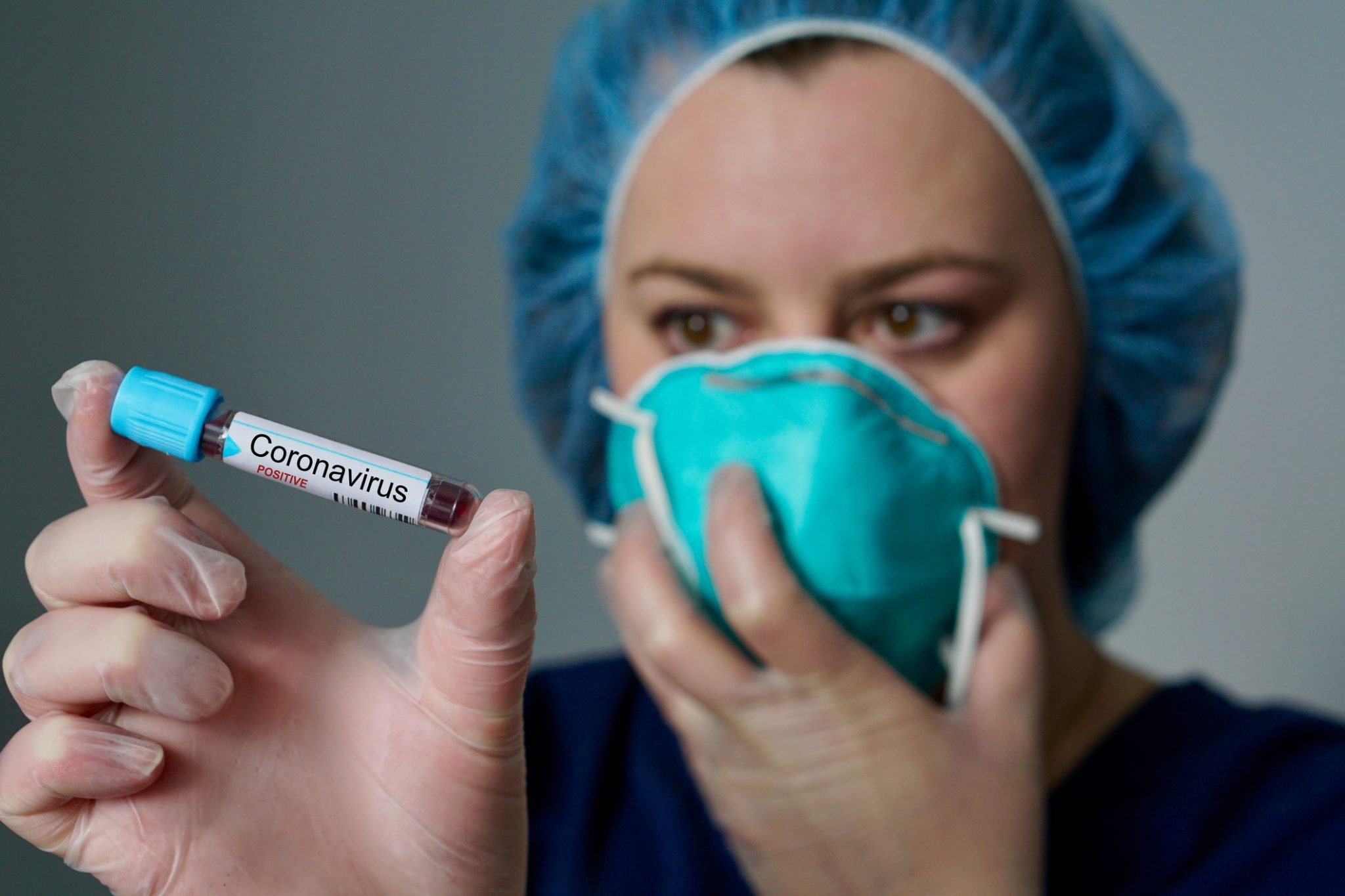
What is the coronavirus?
Coronavirus (CoV) is the family name for a type of virus that causes a range of respiratory infections in humans. Most coronaviruses are very benign and are responsible for mild symptoms like those associated with the common cold. A few coronaviruses, however, are much more dangerous and cause severe symptoms, including death. Some more serious coronaviruses include Middle East Respiratory Syndrome coronavirus (MERS-CoV) and SARS-CoV.
The coronavirus currently in the news is Severe Acute Respiratory Syndrome Coronavirus-2 (SARS-CoV-2), and it was first reported in Wuhan, China, on December 31, 2019. The disease it causes is known as Covid-19.
At any given time, there are countless active cases of human coronaviruses around the world. Coronaviruses are responsible for 15-30% of cases of the common cold, for example. What makes Covid-19 so worrying is how infectious it is, and the fact it can cause lethal symptoms.
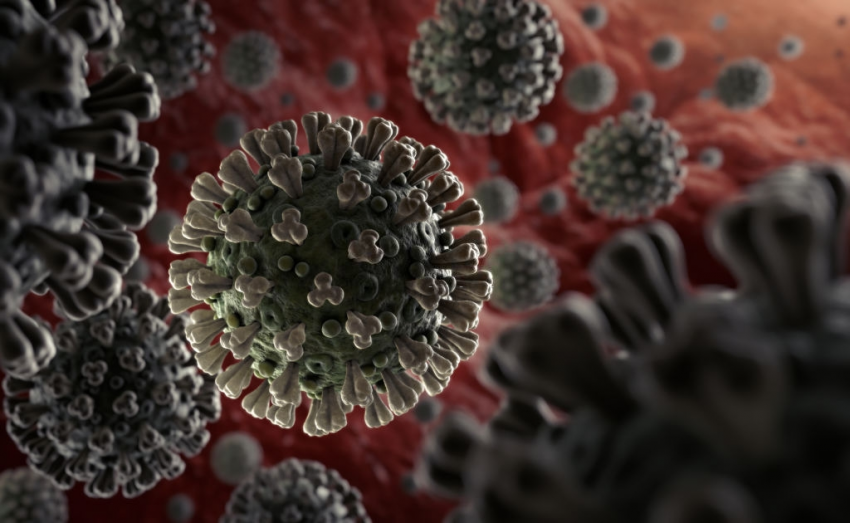
Why is Covid-19 so dangerous?
At the beginning of the pandemic, SARS-CoV-2 was classed as a novel coronavirus, meaning it was new to humans. This made it especially dangerous because nobody had prior immunity, and so everybody was potentially susceptible to infection.
At the time of writing, there are over 237 million confirmed cases of Covid-19 globally, and 4.85 million confirmed deaths.
Pro Tip: You might have seen news reports talking about the morbidity, mortality, and fatality rates of coronavirus. Morbidity means how many people in a population will be affected, while fatality means how many infected people will die. Another measure, the mortality rate, means how many people in the general population (infected or not) will die from the disease.
For example, if Disease A had a morbidity rate of 10%, then there would be 10,000 cases for every 100,000 people. If its fatality rate were 2%, then 200 people of those 10,000 infected would die. That would give it an overall mortality rate of just 0.002% (200 people in every 100,000). Fatality rates are always several factors higher than mortality rates because mortality takes into account the entire population, not just those who are infected.
It could be years before we have an accurate picture of Covid-19’s morbidity, fatality, and mortality rates. There are many reasons for this, including delays in reporting, differences in approaches to social distancing and public health, and access to and uptake of available vaccines.
At the time of writing, the United States has an approximate morbidity rate of 13% (44.1 million cases out of a population of 333.5 million). It has a fatality rate of 1.6% (709,000 deaths from 44.1 million cases). That gives Covid-19 in the U.S. a mortality rate of 0.21%. In 2020, Covid-19 was the third-leading cause of death in the USA, a trend that is continuing through 2021.
The Delta variant
One reason why Covid-19 cases have accelerated this year is due to mutations in the virus. The most concerning of these is the Delta variant, which was first identified in India in December 2020. Delta now accounts for 99% of all new cases in the United States.
Delta is the most dangerous variant identified so far because it is much more infectious than earlier variants. It is about 50% more infectious than the original strain, and that means every person who contracts the Delta variant is likely to infect many more people. This leads to what is called exponential growth, where the cases of Covid-19 double at a much higher rate.
Vaccines against Covid-19
There are three Covid-19 vaccines currently authorized for use in the U.S.
|
Vaccine Name
|
Approved For
|
How Delivered
|
||
|
Pfizer-BioNTech
|
Ages 12+ (12-15 under Emergency Use Authorization)
|
2 shots, 21 days apart (3 shots for severely immunocompromised)
|
Some people are recommended to get a booster after 6 months
|
|
|
2 shots, 28 days apart
|
No booster available
|
|||
|
Johnson & Johnson
|
Viral vector
|
No booster available
|
The mRNA vaccines use the latest science to treat infectious diseases. Most vaccines use a weak or inert version of a virus to teach your immune system how to fight it. This is how the Johnson & Johnson vaccine works, by injecting a different, harmless virus that has been engineered to share enough similarities with SARS-CoV-2 virus to create effective antibodies.
The new vaccines, like the Pfizer-BioNTech and Moderna vaccines, teach your body how to make a protein that is unique to the virus. In the case of the Covid-19 mRNA vaccines, they target the protein spike found on the virus surface.
Our cells follow the code in the mRNA vaccine to make the target protein. Our immune systems recognize the protein as an imposter and create antibodies to remove it. The next time we are exposed to the same protein, we already have the antibodies to get rid of it, and this provides immunity against Covid-19.
Currently, all vaccines provide protection against all known variants of the novel coronavirus. This may change in the future, which is why widespread vaccine uptake is important to protect against Covid-19. The more people are vaccinated, the less chance the virus has to find new hosts and mutate.
Pro Tip: Having immunity to a virus doesn’t mean you never contract it. Instead it means your body can defend itself more effectively if you are exposed. The higher viral load from the Delta variant means more vaccinated people will get symptomatic infections, because the virus can overwhelm their immune systems. However studies show that the current vaccines still provide strong protection against serious disease.
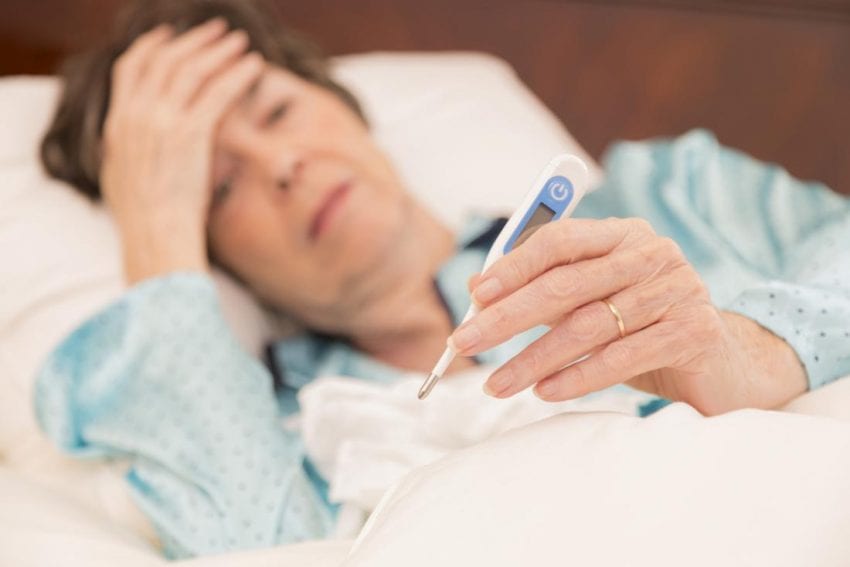
What are the symptoms of Covid-19?
For the majority of people, symptoms of Covid-19 will be mild, cold or flu-like coughs and fevers. Some will experience respiratory distress, while a minority will suffer pneumonia, severe acute respiratory syndrome (SARS), kidney failure, and death. An important early symptom that can be a key identifier of Covid-19 is the loss of taste and smell.
According to the latest data, Covid-19 has an incubation period of up to 14 days, although, on average most people start to show symptoms after 5-6 days. What that means is you can be infected with the virus but show no signs (known as being asymptomatic). The first symptoms to appear are often coughing, fever, and loss of taste and/or smell, sometimes worsening to more serious upper respiratory tract (URT) symptoms as the illness progresses.
According to the CDC, the most common symptoms of Covid-19 are:
- Fever or chills
- Cough
- Shortness of breath or difficulty breathing
- Fatigue
- Muscle or body aches
- Headache
- New loss of taste or smell
- Sore throat
- Congestion or runny nose
- Nausea or vomiting
- Diarrhea
Telling Covid-19 apart from common infections can be difficult because there are so many similarities in symptoms. However, people who develop a fever in tandem with a dry, scratchy cough should contact their doctor.
While the thought of contracting a deadly virus is scary, about 80% of cases are considered mild and patients can recover at home. Of the remainder, 14% of cases are classed as severe, causing breathing difficulties and low blood oxygen saturation. And 5-6% of cases are critical, with patients suffering from respiratory failure, septic shock, and/or multiple organ dysfunction or failure.
Those at highest risk from Covid-19 are people over 65, and anyone who has an underlying condition that leaves them immunocompromised, such as cancer patients, people with diabetes, and those with chronic respiratory or cardiovascular diseases. According to data from the CDC, over 80% of deaths from Covid-19 occur in people over 65, and 95% of deaths occur in people over 45.
Long Covid — What we know
Some people who had otherwise mild or moderate cases of Covid-19 may continue to experience ongoing symptoms for months after infection. This has become known as long Covid, or post-Covid condition. The World Health Organization now recognizes that 10-20% of people may experience long Covid symptoms, which include fatigue, breathlessness, brain fog, and depression.
Long Covid symptoms can emerge while patients are sick with the original infection, or appear up to three months after recovery. They last for at least two months, but in many cases continue for much longer. Long Covid is most common in women aged 35-69, those with other health conditions or disabilities, and people who live in deprived or low-income areas.
How is Covid-19 transmitted?
Early research into the coronavirus molecule suggested that it was transmitted by droplets and fomites (inanimate objects touched by infectious people), but it wasn’t airborne. Today we know that the virus can survive in the air for up to three hours. That means if somebody coughs in a grocery store aisle and you walk down that same aisle an hour later, you could get infected.
Despite this risk, airborne transmission isn’t the most likely way of contracting Covid-19. That remains through contact with respiratory droplets from when people cough, sneeze, or talk. These droplets are too heavy to remain in the air for long, so current guidance is to keep six feet apart from others.
Early data showed that the most likely place to catch Covid-19 was in the home, with household transmission rates up to 30%. New data continues to show that being indoors with lots of other people increases the risk of contracting the coronavirus. Prisons, nursing homes, and food processing plants are other common locations of Covid-19 outbreaks. Dining inside restaurants is also high-risk for Covid-19 transmission.
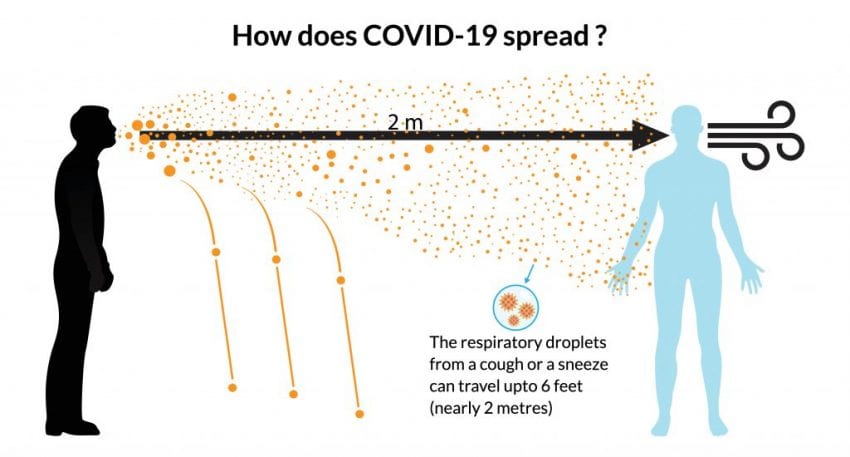
How to prevent the spread of Covid-19
The steps to limit your exposure to SARS-CoV-2 and reduce your risk of catching Covid-19 are very straightforward:
- Wash your hands for at least 20 seconds with soap and water
- Use hand sanitizer with 60-95% alcohol if soap and water is unavailable
- Don’t touch your mouth or face when out in public, and ideally wear a face mask
- Avoid close contact with people who are coughing or sneezing (maintain social distancing)
Studies of the virus show that it has a lipid bilayer, meaning its outer layer is made up of two fat membranes. Household soap is designed to dissolve fats, breaking them apart and making them water-soluble. This means that when the coronavirus SARS-CoV-2 comes into contact with soap and water, it breaks down, and the virus is effectively destroyed.
It’s especially important to wash your hands after being out in public and touching surfaces that may have been touched by others. This includes door handles, handrails, shopping carts, shared pens, and credit card processing machines. While the virus has a low survival rate on inanimate surfaces, it is possible that some cases of Covid-19 have been contracted that way.
Because it’s sometimes difficult to access soap and water when out and about, you can use hand sanitizer as an alternative. Sanitizier is less effective than soap, and not all hand sanitizers are the same. The CDC says you must use a hand sanitizer that is at least 60% alcohol in order to be effective at removing microbes. Even so, the CDC cautions that no hand sanitizer is as effective as washing properly with soap and water.
Pro Tip: You don’t need to use specialist antimicrobial soap to combat this coronavirus. The reason soap is so effective is that it breaks down the virus’s lipid bilayer, destroying it. In viral terms, SARS-CoV-2 is incredibly easy to destroy because of this weakness, and that means plain old hand soap really is the most effective cleaner you can use.
Using a DIY hand sanitizer against Covid-19
You’ve probably seen a lot of recipes for DIY hand sanitizers available online since panic buying began, and many stores sold out. Most DIY recipes suggest combining 91% or 99% isopropyl alcohol (rubbing alcohol) with aloe vera gel. The alcohol provides the antimicrobial properties needed to protect you from the SARS-CoV-2 virus, while the gel prevents your hands from being dried out by the alcohol.
While this works in theory, the problem with all of these recipes is accuracy. Calculate the percentages wrong and you could create a hand sanitizer that’s too strong and will damage your skin, or too weak, in which case it will be completely ineffective. And because these are DIY solutions, there’s no easy way to test them and know if your homemade hand sanitizer is helpful or harmful. There’s also the risk of contaminating your DIY sanitizer if you don’t use sterile equipment when you make it.
You might have seen the recipe for hand sanitizer the WHO published and think that means DIY solutions are recommended for personal use, but the World Health Organization intended its guide to be used by medical practitioners who have access to sterile equipment and alcohol meters that measure the concentration of alcohol in the final mixture. Instead, stick with soap and water.
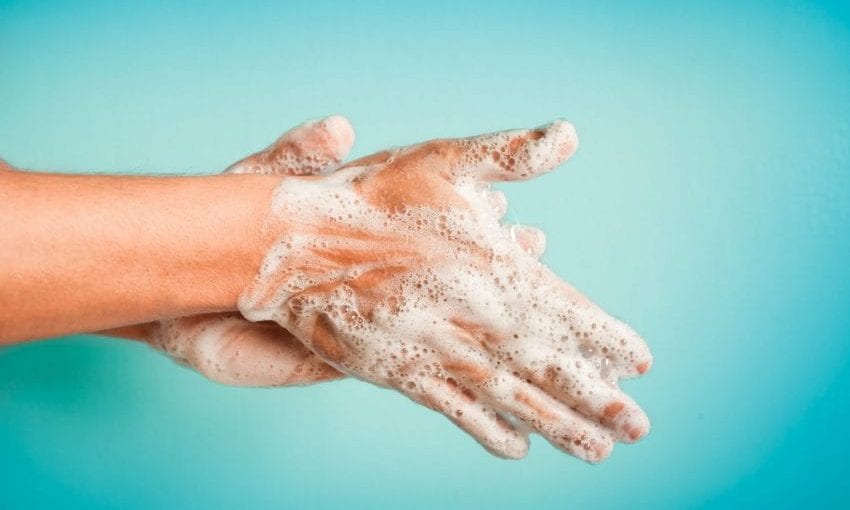
How to wash your hands effectively to kill SARS-CoV-2
While the hand-washing message is getting out, many people are failing to wash their hands effectively enough to kill the virus that causes Covid-19. You should always use soap and water and wash your hands for at least 20 seconds. That’s about the time it takes to sing “Happy Birthday” all the way through twice.
Pro Tip: Sick of Happy Birthday? Try the chorus of Dolly Parton’s “Jolene,” Eminem’s “Lose Yourself,” or Beyonce’s “Love on Top” instead.
Step 1: Wet your hands thoroughly with water
Step 2: Add enough soap to cover your hands in a lather—about 1 standard pump of foam soap, 2 pumps of liquid soap
Step 3: Rub your palms together to lather the soap
Step 4: Place your left palm over the back of your right hand, interlace fingers, and rub back and forth
Step 5: Repeat with the right palm over the left hand
Step 6: Place palms together, interlace fingers, and rub back and forth
Step 7: Make a fist, press your knuckles against your palm and rub the back of your fingers. Repeat for each hand
Step 8: Clasp your hands and rub from the side of your pointer fingers down, enclosing your thumbs
Step 9: Rinse your hands thoroughly with running water
Step 10: Dry your hands thoroughly using a paper towel
Remember to conserve water by turning off the faucet while rinsing your hands. Before washing, you can use your hand to turn off the faucet. After washing, use the used paper towel to touch the faucet. This will minimize the risk of re-contaminating your hands.
When you should wash your hands
There’s very little risk attached to excessive hand washing beyond drying out your skin, so you can feel free to wash your hands as often as makes you comfortable. However, the CDC recommends you wash your hands after these particular circumstances:
- After blowing your nose, coughing, or sneezing
- After using the restroom
- Before eating or preparing food
- Before and after providing care for others
- After touching public surfaces with high contact, such as door handles and shopping carts
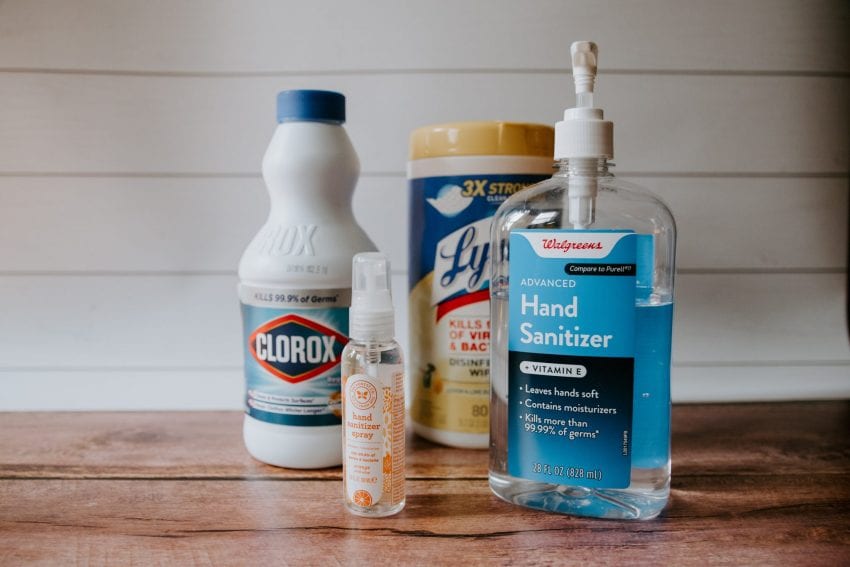
How to properly disinfect and sanitize to avoid Covid-19
Transmission of Covid-19 is most likely between people in close proximity to each other, which means keeping your workplace clean is the most important thing you can do to prevent community spread. At Pro Housekeepers, we’ve investigated all the claims about what works and what doesn’t to bring you the latest information on what Covid-19 disinfection cleaning methods and solutions are the most effective at destroying this novel coronavirus.
What cleaning products kill the coronavirus?
Because this coronavirus has a lipid bilayer, any cleaner that’s designed to destroy fats is going to be highly effective at killing the virus in your home or workplace.
The Environmental Protection Agency (EPA) has released a list (known as List N) of antimicrobial products that are suitable for use against SARS-CoV-2. These include:
- Clorox Multi-Surface Cleaner + Bleach
- Clorox Disinfecting Wipes
- Lysol Heavy-Duty Cleaner Disinfectant Concentrate
- Lysol Disinfectant Max Cover Mist
- Lysol Clean & Fresh Multi-Surface Cleaner
- Purell Professional Surface Disinfectant Wipes
- Sani-Prime Germicidal Spray
There’s no need to use any of these detergents more often or for longer than they recommend on the label. All of these products meet the EPA’s criteria for use against SARS-CoV-2.
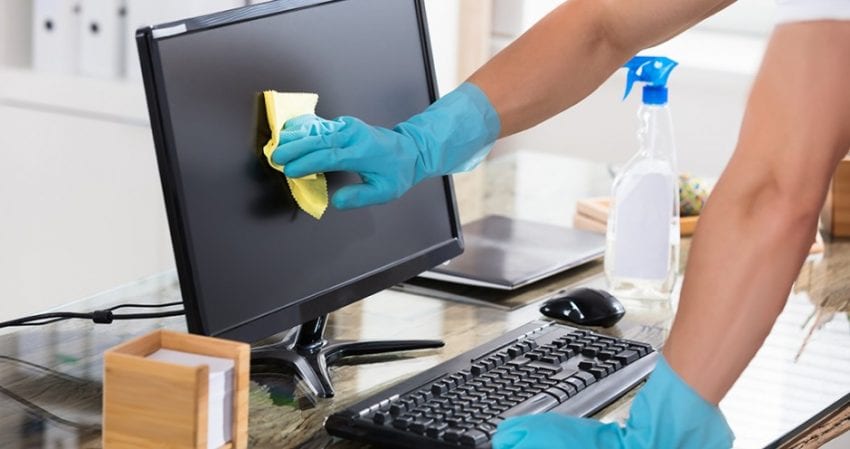
How to disinfect surfaces against coronavirus
You can check if your cleaner is suitable for use to protect against COVID-19 by looking up the EPA registration number on the EPA website. There you will find if the cleaner has the coronavirus listed as a target pathogen.
Alternatively, you can clean surfaces with a simple bleach solution:
Step 1: Put on a pair of disposable rubber gloves
Step 2: Clean any visibly dirty surfaces using detergent or soap and water
Step 3: Make a bleach solution by adding 5 tablespoons (⅓ cup) of bleach to 1 gallon water
Step 4: Wash down surfaces using the bleach solution
Step 5: Rinse surfaces with clean water and dry thoroughly using a microfiber cloth or paper towels
Step 6: Dispose of the cloths, paper towels, and gloves used for cleaning
Step 7: Wash hands for at least 20 seconds using soap and water
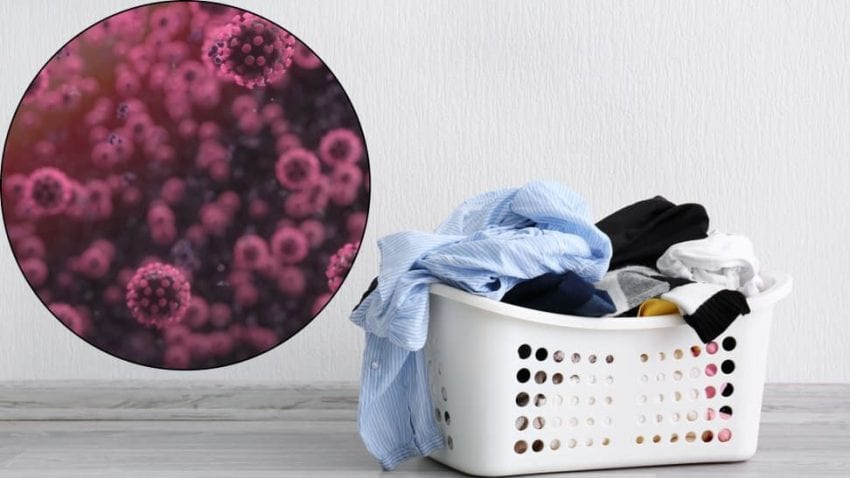
How to clean soft surfaces to kill coronavirus
Although SARS-CoV-2 is unlikely to survive long on soft surfaces, it’s still a good idea to maintain a thorough cleaning routine during the outbreak to minimize the risk of transmission. The CDC recommends cleaning porous surfaces such as carpets, curtains, and clothes using appropriate cleaning solutions according to the manufacturer’s instructions. Many detergents are designed to work effectively on lipids and will be suitable for breaking down the virus that causes Covid-19.
Where possible, use hot water for the materials you’re cleaning, and ensure you completely dry all items. Don’t forget to clean your washing machine after using it to clean any items that might have been contaminated.
How to clean the laundry of an infected person
If you’re cleaning clothes, towels, and linens used by a person who might be infected with Covid-19, there are some simple steps to take to ensure you stay safe.
Step 1: Use disposable gloves when handling laundry and discard them after you’re done
Step 2: Avoid shaking clothes to prevent scattering any droplets containing the virus
Step 3: Wash fabrics using a detergent and the hottest water suitable for the material
Step 4: Ensure all items are dried thoroughly
Step 5: Clean the liner of any laundry hampers they may have used, or consider switching to plastic bags and dispose of them after use
Step 6: Clean the washing machine and dryer
Step 7: Discard gloves and wash your hands immediately using soap and water
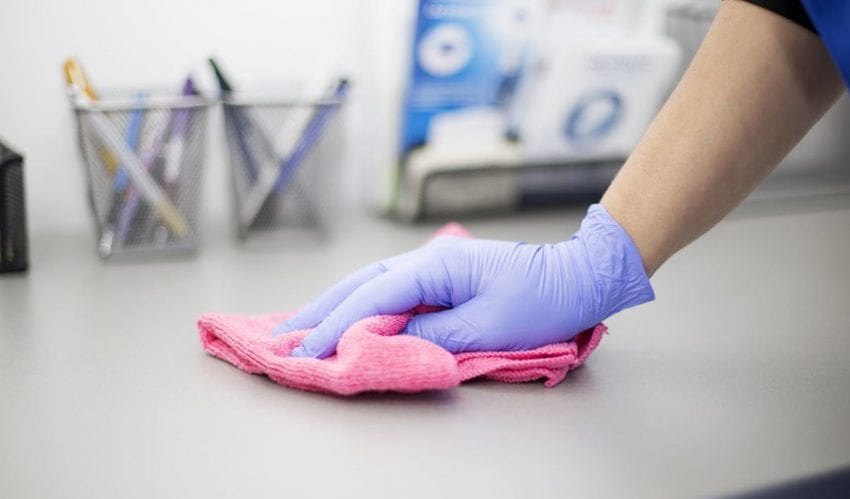
How often to clean to protect against coronavirus
Frequent cleaning is most effective at eliminating any SARS-CoV-2 pathogens that might be in your workplace. Encourage your staff to use household cleaners or disinfectants registered with the EPA to clean high-touch surfaces such as door handles, light switches, desk surfaces, toilets, faucets, and sinks, as often as they are used, especially if your workplace admits the public and it’s harder to control who touches what surface.
At home, clean high-touch surfaces after new contaminants have been potentially introduced. For example, after family members return from work or running errands. Encourage all members of your household to wash their hands with soap and water for at least 20 seconds upon reentering the home and wipe down any surfaces they might have touched before doing so.
To prevent community spread, try to clean all the major surfaces of your home and workplace on a daily basis. This should minimize the risk of accidental transmission if you come into contact with a person shedding Covid-19 in public.
If there has been a known exposure to Covid-19, immediately clean all surfaces using EPA-approved disinfectants. If the exposure is ongoing, for instance, a member of your family is sick with Covid-19, consider reducing the frequency of cleaning in the sick person’s room in order to minimize exposure to the virus.
Encourage the ill person to remain in one area of the house and provide them with personal cleaning supplies. If isolation within the home isn’t possible, other members of the household should wait as long as possible before touching any surface the sick person has used. This will increase the chances of the virus dying on the surface before it has a chance to infect somebody else.
The CDC has also provided a detailed home care guide for keeping you and your family safe.

The most at-risk places for contracting Covid-19
Unless a member of your household or workforce is already exhibiting symptoms, the most likely place for transmission is out in public. Human-to-human transmission remains the most common way people are becoming infected, so try to avoid any areas where you’ll be in close proximity to lots of other people. Public transport systems such as subways are an obvious location where your proximity to a lot of strangers is high.
Most infections occur between people less than six feet apart, so simply by maintaining distance from others, you’re protecting yourself from contracting Covid-19. It’s also a good idea to steer clear of anyone who is coughing or sneezing because the virus is transmitted most commonly through respiratory droplets.
When you leave home, wearing a face covering, even a homemade mask, can help keep everybody safe.
Those who should take extra precautions include people over 65, and those who are suffering from preexisting conditions including respiratory diseases such as COPD, cancer patients, and the immunocompromised.
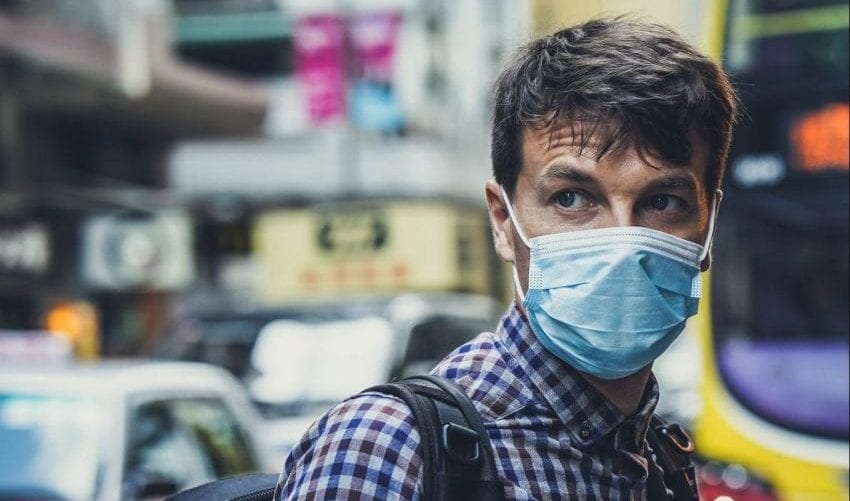
How to clean your workplace to protect against Covid-19
Staying on top of regular cleaning is important to keep your workplace safe from the risk of infection from any virus or bacteria, not just Covid-19. By following this guide, you can play a part in protecting your employees and coworkers from common causes of exposure:
Cleaning entry and reception areas
The areas where the most people come and go are at most risk of viral contamination. You’re less likely to be able to control who enters your workplace, or what they touch. Therefore these areas should be cleaned regularly in order to minimize the risk to your workforce.
Door handles will be the most frequently touched objects in the room. Try to wipe them down with an EPA-approved disinfecting solution between uses, or on a regular schedule depending on how busy your workplace is. Don’t forget to clean the door or window beside the handle, as more people will touch there instead of the handle itself if they’re also trying to avoid possible exposure to the virus.
The front of reception desks are often leaned on or touched by visitors, and also need to be regularly wiped down. If possible, use a disinfecting wipe after each contact. If that isn’t possible, either because your workplace is very busy, or to avoid being seen by and upsetting visitors, try to wipe down the desk at regularly scheduled intervals.
Consider putting away any pens that you usually make available for public use. Instead, offer visitors a pen if they need one, and ensure it’s cleaned before being reused. If you usually display business cards for visitors to take, consider removing the cardholder and offering visitors a card instead.
Clean point-of-sale card readers according to the manufacturer’s instructions to avoid damaging the machine.
If you have a waiting area with chairs and tables, try to wipe them down using EPA-approved disinfectants after each use. If your waiting area is usually busy, take advantage of lunch hour if your workplace is closed to the public or quiet periods in the day when you can clean. Pay attention to armrests and other places where people most usually place their hands.
Remove any magazines, toys, and other distractions you might put out to entertain waiting visitors. These items are often too difficult to clean effectively. If you do choose to keep some distractions available, particularly toys, choose ones with surfaces that are easy to access for cleaning.
If your staff members have individual, wired telephones, clean them with disinfectant wipes before the start of each shift, and before and after any other person uses the phone. Pay particular attention to the handset and the dial pad. Consider removing shared telephones, as they’re harder to keep track of cleaning and more likely to result in any sickness spreading rapidly through your company.
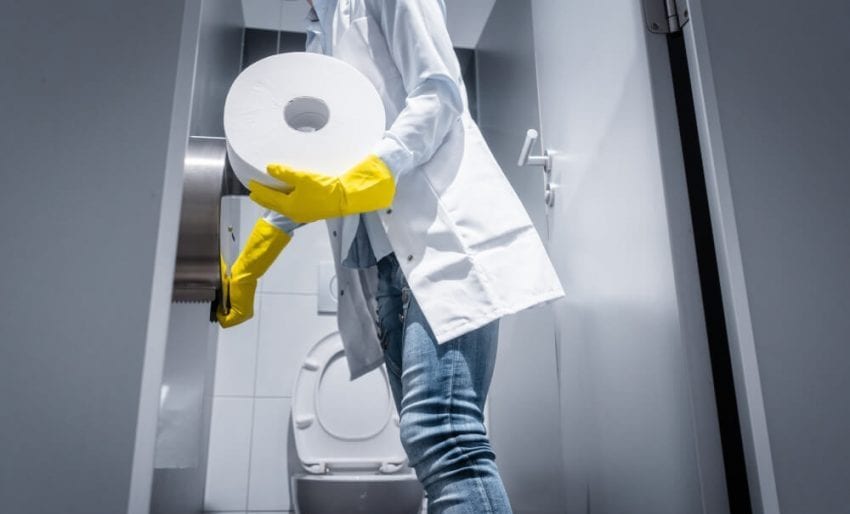
Cleaning desks and conference rooms
For the most effective containment of any type of virus or infection in the workplace, it’s best if your staff have their own desks and chairs. If this isn’t possible, ensure that everything is wiped down between changes.
Desk surfaces should be cleaned with EPA-approved solutions when new staff members begin to use them, and after anyone has eaten at the desk.
You should also encourage employees to clean telephones and computer mice and keyboards at the start of each shift, and before and after changing users.
Cleaning break rooms and kitchens
Covid-19 is most commonly transmitted through close contact, so having many employees eating in the same area could increase the risk of the virus being transmitted through your workforce. Encourage all employees to clean tables and chairs before and after each use with disinfectant wipes.
Wash shared plates and utensils with hot, soapy water, and dry thoroughly using disposable paper towels. If you have a shared microwave, coffee maker, cooking facilities, or water dispenser, make sure they are all wiped down before and after each use. Charge one employee with the responsibility of cleaning the handles and buttons of the most commonly used appliances to ensure they are all disinfected on a regular basis.
Cleaning bathrooms
While it isn’t your employees’ duty to clean the bathrooms in your workplace, they can take precautions to minimize the spread of all diseases in this area. Encourage them to avoid touching door handles, toilet handles, and faucets with bare skin, and to wash their hands thoroughly after using the restroom. Make sure the soap dispensers are filled, you provide plenty of disposable paper towels, and have your cleaning company pay extra attention to high-touch areas during nightly cleans.
After hours cleaning
When your workplace is closed is the best time for intensive cleaning. Your regular cleaning company probably already takes most of the necessary precautions to minimize the risk of disease transmission, but ask them to use EPA-approved cleaners, and to focus on high-touch areas such as telephones, keyboards, and door handles.
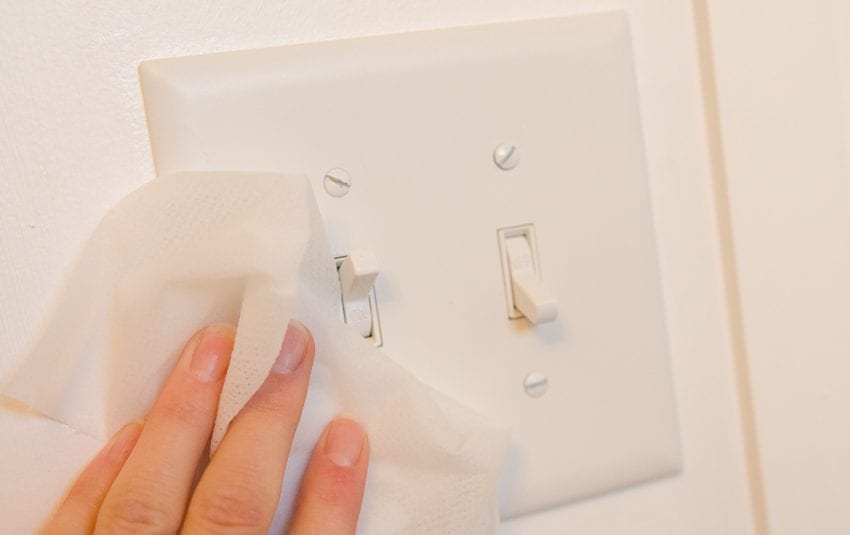
How to clean your home to protect against Covid-19
At home, you’re the most protected against SARS-CoV-2. Providing nobody in your household is showing symptoms, your main concern should be in minimizing the risk of introducing the virus into the house. You can do this by encouraging everybody to wash their hands as soon as they enter, and regularly wiping down high-touch areas such as door handles, light switches, TV remotes, and faucets using EPA-approved disinfectants.
Maintaining a clean home is always a good idea to protect against all kinds of infections and viruses. A clean home can help you stay healthier and live longer. Covid-19 isn’t the only organism that can make you and your family sick, but there are steps you can take to reduce your risk of infection at home.
For more assistance, follow Pro Housekeepers’ simple checklist to stay on top of keeping your home clean.
Don’t panic
While the news might be full of horror stories about Covid-19, there’s no need to panic. The steps you need to take to minimize your risk of contracting the virus are straightforward and simple. Maintaining good cleaning habits and regular hand washing are the best things you can do to keep yourself, your workplace, and your family safe.
At Pro Housekeepers, we know a thing or two about keeping your home and business germ-free. Our cleaning pros are trained to get the spots that other cleaners miss, and they know the best cleaning solutions to use on every surface. Whether you’d like to have your home or workplace cleaned to minimize the risk from Covid-19, or just enjoy the results of a visit from a professional cleaning service, Pro Housekeepers is here to help.
Contact us today to see how we can help you protect your workforce and household from germs all year round.
Published at Thu, 14 Oct 2021 09:30:50 -0500
You might think your kitchen is clean and tidy, but what germs might be lurking where you can’t see them? Germs love warm, damp environments, and the inside of your coffee maker is the perfect place for them to multiply. A 2011 study found that coffee makers could contain all kinds of harmful nasties, from yeast and mold to coliform bacteria — that’s the family of bacteria responsible for salmonella and E. coli.
If you’re worried what might be lurking in your coffee maker, don’t panic. Our cleaning Pros know a thing or two about getting into even the hardest to reach areas. Follow these tips and keep your coffee maker as clean as new!
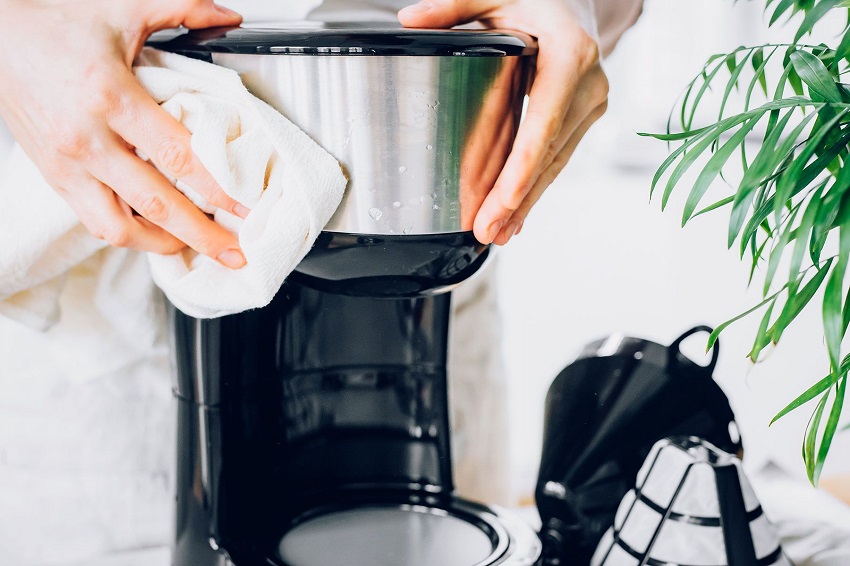
How often to clean coffee maker
You should clean your coffee maker every 2-4 months, depending on how regularly you use it. However, that doesn’t mean you should ignore it the rest of the time. Mold likes darkness and humidity, so one of the best ways to avoid mold growth is to open the lid of your coffee maker when it’s not in use. This helps the water inside to evaporate and lets light reach the insides where mold likes to grow.
If you notice your coffee tastes bitter, or the coffee maker has a strong odor when in use, it’s time for a cleaning, even if it hasn’t been very long since it was last done. There are many variables that can affect coffee makers, from water hardness to the type of bean you use, so look for signs your coffee maker is getting dirty. A buildup of mineral deposits (also known as limescale) can affect the performance of your coffee maker and ultimately reduce its lifespan.
How to clean a coffee maker
There are many commercial coffee maker cleaning solutions available on the market. These products are often sold as de-scaling solutions and are available as tablets, powders or liquids. Most work using the following method, but always follow the instructions on any commercial cleaning product.
Step 1 — If your coffee maker has a reservoir, measure your cleaning solution and add it to the water reservoir.
Step 2 — For tablet and powder cleaning solutions, add enough water to activate the cleaner. Refer to the product packaging for details.
Step 3 — Run your coffee maker as usual until the reservoir is empty. Discard the dirty water.
Step 4 — Fill the reservoir and repeat.
Step 5 — Remove any remaining cleaning product from the reservoir and discard.
Step 6 — Fill the reservoir again with clean water and run at least two cycles to remove any last traces of the cleaning product.
Pro Tip: Your coffee maker isn’t the only humid spot in your kitchen. Keep mold at bay by cleaning your dishwasher too!
How to clean coffee pot stains
Coffee makers and coffee pots often suffer from a variety of stains. From the coffee itself, to hard water marks and buildup of limescale. The good news is all of these stains can be removed with a little TLC.
- To remove coffee stains from your coffee pot, fill it with boiling water and add a dishwasher detergent pod (or a squirt of dish soap). Let it sit for half an hour before emptying and rinsing with clean water.
- Use salted water to remove stains. Salt is a natural abrasive and strongly absorbent, so it has great cleaning properties. Sprinkle salt inside the coffee pot, leave for 5-10 minutes, then fill with boiling water. Stir to dissolve the salt and then let sit for 30-60 minutes before emptying and washing with fresh water.
- Most hard water deposits are made from calcium carbonate, a base. You can use acidic substances to break them down and remove them. This includes vinegar, lemon juice, and citric acid. Just use a 50/50 mix of water and your acid and soak the coffee pot to remove the stains.
Pro Tip: Keep cleaning! Learn how to clean your oven like a Pro
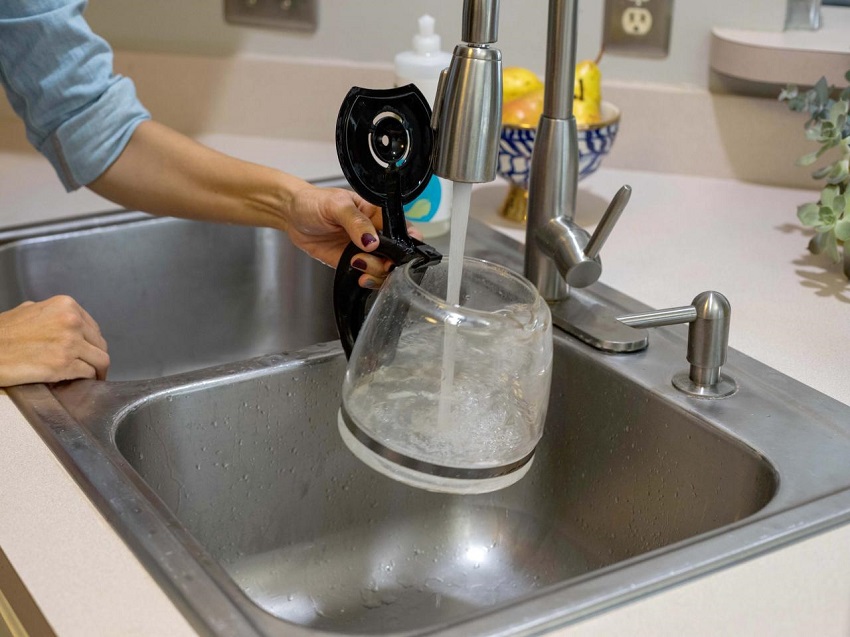
How to clean a coffee maker with vinegar
Vinegar is a fantastic all-purpose cleaning solution. It’s food safe, so it can be used on your coffee maker without risking your health if you don’t remove it all (although that will make your next cup of coffee taste funky!).
Step 1 — Fill the reservoir with 50/50 white vinegar and water.
Step 2 — Run a brew cycle, but stop the coffee maker halfway through.
Step 3 — Let the coffee maker sit for 30 minutes to allow the vinegar to work.
Step 4 — Complete the brew cycle and discard the dirty water.
Step 5 — Run at least two cycles of plain water, until you can no longer smell any vinegar in your coffee maker.
That’s all you need to do to clean your coffee maker! You can use distilled vinegar, white vinegar, or clean your coffee maker with apple cider vinegar. Don’t worry about the flavor or odor. As long as you flush the coffee maker thoroughly after cleaning with vinegar, you won’t notice any unpleasant smell or taste.
If you aren’t sure you flushed the vinegar well enough, try making a small test cup of coffee to see. It might not taste great, but vinegar isn’t harmful so there will be no negative side effects.
Pro Tip: Your humidifier can also get dirty and attract mold. Learn how to keep your humidifier clean now.
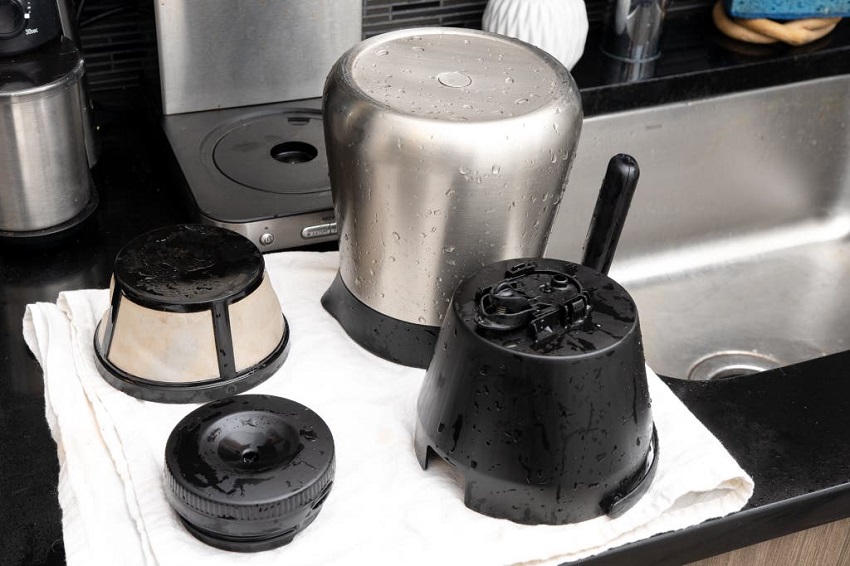
How to clean a coffee maker without vinegar
If you don’t have vinegar available, you can use citric acid or lemon juice instead. They work just as well as vinegar because they’re also mildly acidic. This helps to break down the calcium carbonate that collects inside coffee makers. Many people prefer using lemon juice or citric acid as a cleaner because the smell is more pleasant than vinegar. However, lemon juice in particular can be sticky if it isn’t thoroughly removed.
Both lemon juice and citric acid (which is really just the scientific name for lemon juice!) are food safe, so you don’t have to worry about any harmful side effects. You can use fresh lemon juice or a bottle of store-bought juice to clean your coffee maker.
Pro Tip: Keep cleaning, and keep pests at bay. Learn how to get rid of gnats!
How to clean a coffee maker with baking soda
Baking soda is also a great cleaning product, particularly if you combine it with other cleaners.
- Try filling a stained coffee pot with boiling water and add 2 tablespoons of baking soda. Stir to dissolve and let sit for 30 minutes to remove stains.
- Fill the reservoir and add 1/2 cup baking soda. Run the coffee maker to flush the machine. Discard the water. Run two more cycles with fresh water to remove any last residue.
- Add a tablespoon of baking soda to the bottom of your coffee pot before running a cleaning cycle with vinegar or lemon juice. The reaction between the soda and the acid will create even more amazing cleaning power!
- You can also use baking soda to test if you’ve successfully cleaned all the vinegar/citric acid/lemon juice out of your coffee maker. Add a pinch of baking soda to the bottom of the coffee pot and run a freshwater cycle. If you see any fizzing, there’s still some acid in there!
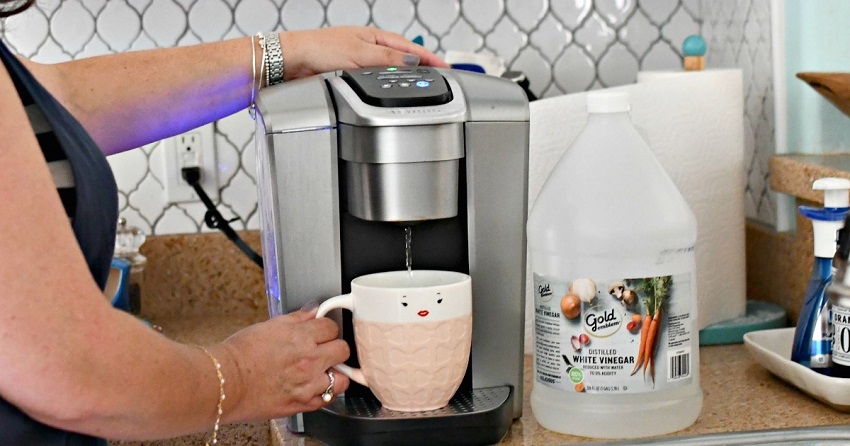
How to clean a single-serve or Keurig coffee maker
Most commercial coffee maker cleaning products can be used on single-serve (Keurig-style) coffee makers. You can also create a DIY coffee maker cleaning solution with vinegar, citric acid, or baking soda, and they are safe to use on single-serve machines. Always add the cleaner to the reservoir and run the cycle without installing a K-cup.
Note that Keurig only recommends one brand of cleaning and descaling solution for its machines, and recommends that their coffee makers be cleaned every 3-6 months, depending on usage.
In conclusion
Cleaning your coffee maker is a simple task, but one that often gets overlooked. With the Pros in your corner, you can keep your coffee maker cleaned and stay ahead of mold, bacteria, and limescale. Not only will your family stay healthier, but your coffee will taste better too!
Published at Sun, 03 Oct 2021 12:03:55 -0500
{articles|100|campaign}How To Clean An Oven Like A Pro
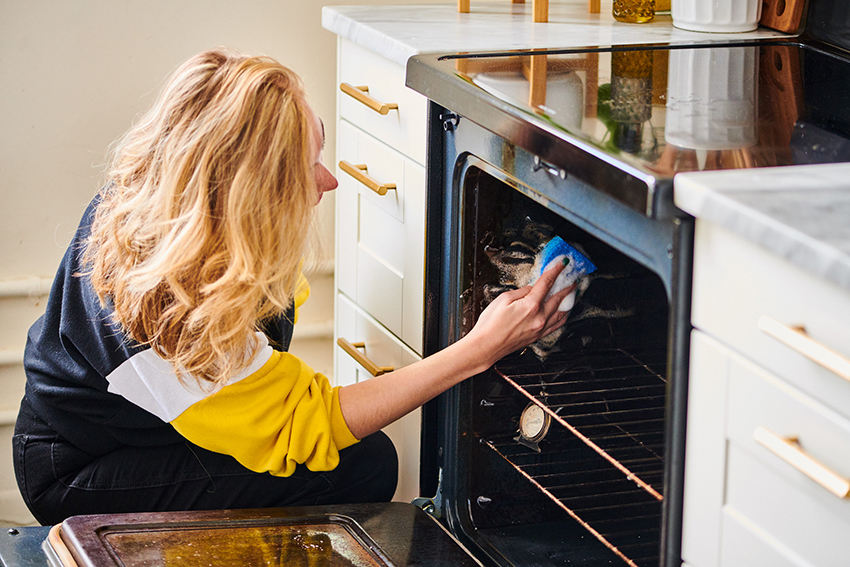
Many people don’t realize that their oven needs to be cleaned and maintained on a regular basis, just like anywhere else in your home. Your oven can actually harbor bacteria and food spills, and this can make it hard to prepare meals without fear of illness. Not to mention all the nasty grease and burned food residue that builds up over time! Luckily, our Pros know a thing or two about how to get ovens sparkling clean. This article lists out how to clean your oven and what supplies you’ll need to do so.
Follow these simple steps to keep your oven looking clean and shining.
How to clean the inside of an oven
There are many ways to clean inside your oven. You can use a commercial oven cleaner, or you can make your own at home. More important than the cleaning solution you use is how frequently you clean your oven.
You should wash it out with water about once a month. This prevents your oven from becoming coated in grime. And always wipe down your cooled oven after cooking anything particularly messy. This helps prevent grease and dirt from accumulating.
You’ll Need:
- Commercial oven cleaner, OR white vinegar and baking soda
- Sponge
- Microfiber cloth
- Plastic food scraper
- Clean water
- Paper towels
- Spray bottle
Step 1: Switch off your oven and allow it to cool. Never try to clean your oven while it’s hot. Not only is it dangerous, but any cleaning solutions you use can burn, releasing toxic chemicals or even just leaving unsightly stains behind.
Step 2: Remove the racks from your oven and soak them in a solution of hot, soapy water while you clean your oven.
Step 3: Apply your cleaning solution. Make sure to get all the sides and top of the oven, as well as the floor. If you have an electric oven, you can apply cleaner to the heating coils.
Step 4: Give your oven a good scrub with a sponge or microfiber cloth. Avoid anything that could scratch the finish, such as steel wool. If the cleaning solution you use turns brown, that just means it’s lifting dirt from your oven.
Step 5: If your oven is very dirty, apply a second coat of cleaning solution and leave it overnight to work its magic before continuing to clean.
Step 6: Using a damp microfiber cloth, wipe away the cleaning solution residue and lift dirt and debris. You can use a spatula or plastic pan scraper to remove any tough burned-on food. Avoid using anything metal that might damage your oven.
Step 7: Give your oven a final wipe-down with clean water, making sure you’ve removed every trace of cleaning solution. You can use paper towels to dry your oven, or turn it on to the lowest heat for 15 minutes to dry out.
Step 8: Reinstall the oven racks and enjoy your gleaming clean oven!
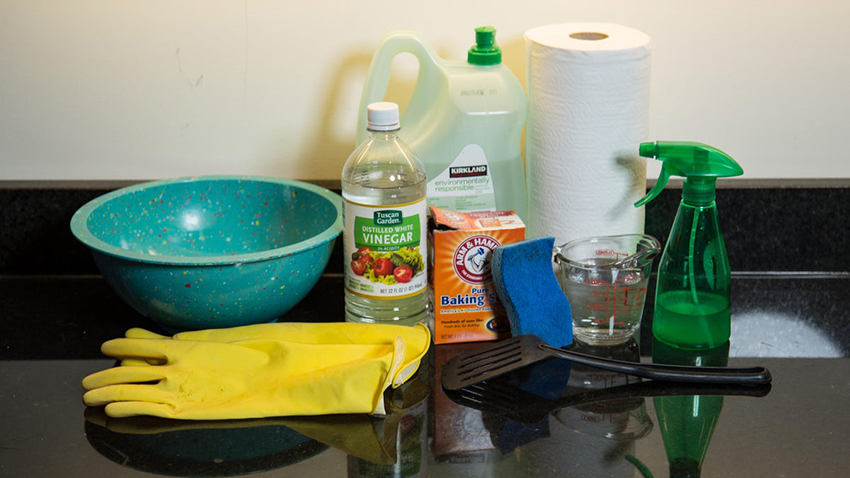
How to clean a gas oven
If you have a natural gas oven, you might be nervous about cleaning it without causing any damage. However even gas ovens are designed to be completely cleaned inside, so you should be able to clean it just as effectively as any other type of oven.
Pro Tip: Always be gas safe. Make sure your oven is completely cooled before cleaning, and if you smell natural gas, call your gas company’s emergency line or dial 911 immediately.
How to clean an electric oven
Electric ovens often have an exposed heating element at the top and/or bottom of the oven. They may also have a convection fan at the back of the oven to help circulate hot air evenly.
Generally, you don’t have to worry about getting cleaning solution on any of these parts. They are all perfectly safe to clean as long as you use a cleaner that is appropriate for use on domestic ovens.
Some cleaners, such as Easy-Off, cannot come into contact with heating elements. If in doubt, cover the elements with foil, or use a different cleaning solution.
Pro Tip: Oven clean? Now learn how to clean your dishwasher!
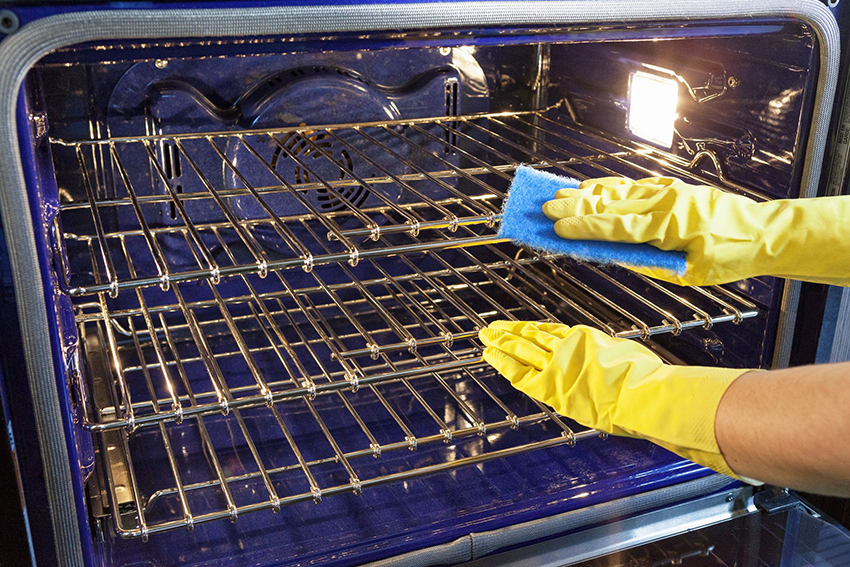
How to clean oven racks
Sometimes your oven racks can get just as dirty as the oven itself. Most oven racks are made of stainless steel, and can be cleaned easily. If they aren’t very dirty, you can just wipe them down with a damp rag and some mild dish soap, or for more intensive cleaning, soak them in hot, soapy water.
Pro Tip: Sink too small for your oven racks? Clean them in the bathtub!
Another easy way to clean oven racks is to use a trash bag and ammonia. You can purchase commercial bag cleaning kits for oven racks, but it’s just as easy to make your own!
You’ll Need:
- Trash bags
- Ammonia
- Clean water
Only use ammonia in a well ventilated area, and wear gloves and a mask. Place your oven racks in the trash bag and add 2 cups of ammonia. Tie the bag and leave it overnight. Remove the racks in the morning, taking extra care because the ammonia fumes will have concentrated inside the bag. Rinse the racks thoroughly to remove any last dirt.
Pro Tip: Keep cleaning! Learn how to clean your microwave
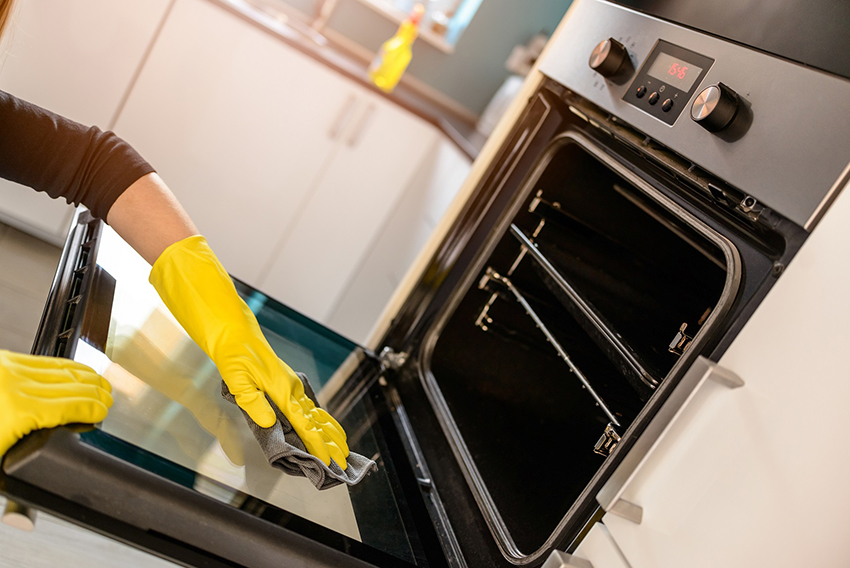
How to clean the glass on the oven door
One place you’ll quickly notice grease buildup and food spatter is on the glass of your oven door. If you’re struggling to see what’s going on inside your oven, it’s time to get cleaning. Always make sure the oven is completely cooled before attempting any cleaning, to avoid burns.
You’ll Need:
- 50/50 white vinegar and water mix
- Sponge
- Microfiber cloth
- Clean water
- Vacuum hose attachment
- Spray bottle
As part of your routine cleaning, use a 50/50 mixture of water and white vinegar to spritz the glass and cut through grease. This will keep the door in good condition and prevent dirt from accumulating. You can also use a damp microfiber cloth with a small dab of dish soap to achieve the same effect.
If there are any crumbs or debris between the glass and the door, you can remove the glass from your oven door to access the cavity. Open the door and undo the screws along the top to lift the glass free. You can use your legs to support the door and prevent the glass from falling if it isn’t securely held once the screws are removed. Use a vacuum hose attachment to remove dust and crumbs, and then wipe down the cavity with a damp microfiber cloth.
You can also use commercial oven glass door cleaners to achieve the same effect. And if your oven is really grubby, consider letting it run a cleaning cycle. This can take 2-4 hours, so don’t do it on a day you’ve got a big dinner planned! Also ensure your kitchen is well ventilated, because the high heat from the cleaning cycle can make the oven give off unpleasant fumes.
Pro Tip: Got sticker residue on your door? Find out how to remove sticker residue from any surface!
How to clean an oven with Easy-Off
Easy-Off is a popular brand of odor-free oven cleaner. It’s one of the best oven cleaner sprays on the market. Easy-Off is safe to use in self-cleaning ovens, gas ovens, and electric ovens, although for electric ovens you must cover the heating element with foil before applying Easy-Off cleaner.
Always ensure your oven is turned off and completely cooled before applying Easy-Off cleaner. Spray the cleaner all around your oven, close the door, and allow it to sit for 2 hours. This gives time for the cleaning foam to penetrate any dirt or burned-on food inside the oven.
After 2 hours, remove the Easy-Off foam using a sponge or microfiber cloth dampened with clean water. Don’t use any other cleaning solutions at the same time you use Easy-Off oven cleaner. You may need to rinse out the sponge or cloth frequently until all the cleaner has been removed.
Pro Tip: Clean the top of your stove as well with these tips on cleaning a glass top stove
How to clean an oven without oven cleaner
If you don’t have a commercial oven cleaner available, it’s easy to make an oven cleaner DIY solution. Two of the best ingredients for tough cleaning jobs are white vinegar and baking soda. Find out how to use them to clean your oven by reading the instructions below.
How to clean an oven with vinegar
White vinegar is an amazing cleaning solution for every part of your home, not just your oven! You can use vinegar in a spray bottle to spritz the oven on a regular basis to keep dirt and grime from building up. White vinegar is also an effective cleaner when your oven is in bad need of some TLC.
You’ll Need:
- 50/50 white vinegar and water mix
- Sponge
- Microfiber cloth
- Clean water
- Spray bottle
- Oven safe dish
Step 1: Make a 50/50 mixture of white vinegar and warm water.
Step 2: Use a spray bottle to apply the mixture to the inside of the oven.
Step 3: Use a sponge or microfiber cloth to wipe down the oven, repeating until the sponge or cloth no longer comes away dirty.
For more intensive cleaning, you can use white vinegar to loosen dirt and cut through grease inside your oven.
Step 1: Place an oven safe dish, such as a casserole dish, inside your oven on the bottom shelf.
Step 2: Make a 50/50 mix of water and white vinegar in a pan and bring to a boil.
Step 3: Carefully pour the boiling vinegar/water into the casserole dish inside the oven.
Step 4: Leave inside the oven for an hour to cool. The vinegar steam will help loosen any grime.
Step 5: Wipe down the oven using a clean, damp cloth.
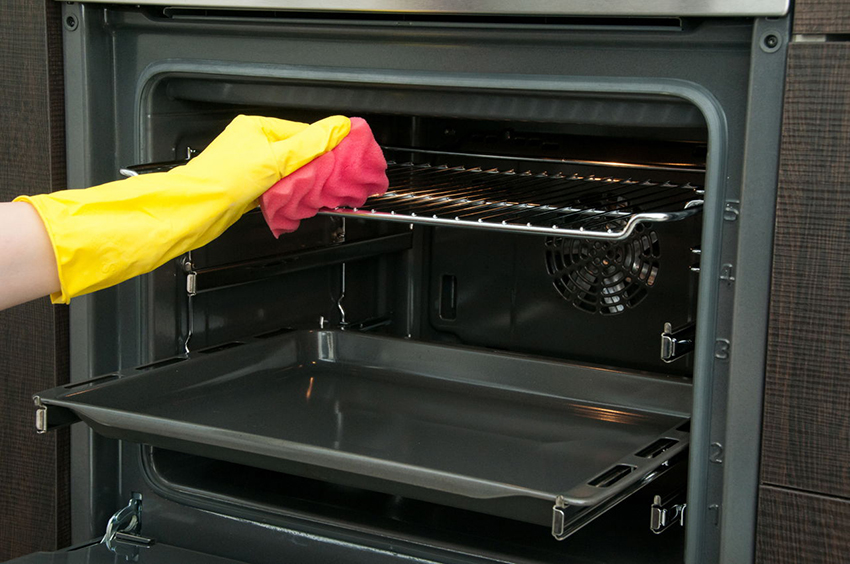
How to clean an oven with baking soda
If your oven is very dirty, baking soda is what you need to get the job done.
You’ll Need:
- Baking soda
- Water
- Sponge
- Microfiber cloth
Make a paste of baking soda and enough water to get the right consistency. Spread the paste all over the oven interior and leave for 30 minutes. Then scrub the oven to lift any buildup.
If you have a lot of burned on food to remove from the floor of your oven, sprinkle baking soda across the buildup and then spray white vinegar onto the baking soda. The reaction between the two will help dislodge stubborn messes.
Use a damp sponge or microfiber cloth to remove the baking soda (and vinegar, if used) from the oven. Wash clean with clear water to remove any last residue.
Pro Tip: Keep cleaning! Now learn how to clean your washing machine
It’s easy to clean the inside of an oven with the Pros on your side!
Now you know how to clean an oven, no matter what mess it got into. To keep your oven in optimal condition at all times, you’ll need to practice using these procedures on a regular basis. Remember to always clean your oven after any food spills, and add cleaning your oven to part of your regular cleaning routine.
Published at Tue, 28 Sep 2021 17:05:35 -0500